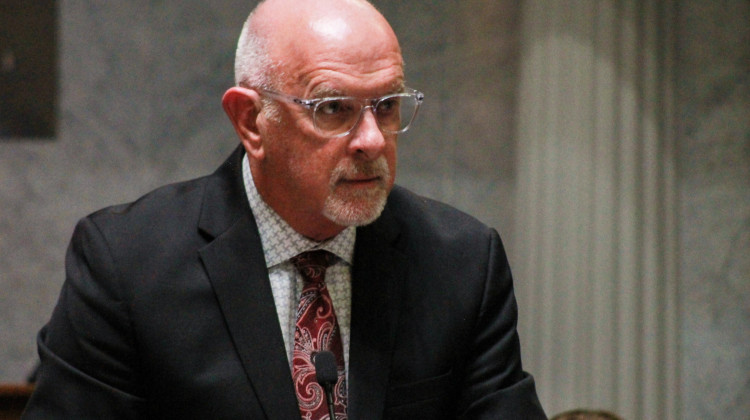
Indiana Department of Natural Resources guide Andrew Norrington takes a group into the Twin Caves Boat Tour at Spring Mill State Park on June 4, 2022.
Tim Jagielo/WNINCool water gently trickles overhead in the darkness of the Twin Caves boat tour at Spring Mill State Park in Mitchell, Indiana.
It’s a cool 54 degrees fahrenheit. The craggy, wetted walls of the cave slide by in patches of light cast by Indiana Department of Natural Resources guide Lucas Brown. Up to eight passengers can fit in these long, narrow stainless steel boats, which he moves along the narrow cave by hand. He wears gloves to protect the environment.
The first thing he talks about is limestone, which comprises the entire cave system.
“Down here in southern Indiana we are known as the ‘limestone capital of the world,’” said Brown, adding that there are several rock quarries in the region. “You've probably seen (Indiana limestone) in several famous places like the Washington Monument or the Empire State Building.”
Southwestern Indiana is rich with coal, but this area of south-central Indiana is full of limestone. While limestone can be seen almost anywhere in the man-made world, these tours offer another glimpse of the important rock in a natural environment.
“Of course, Bloomington has probably the most amount of limestone from Lawrence County in one area,” said DNR Interpretive Naturalist Sheree Belt. “So economically, it plays a huge role for us here in this area. But ecologically, the caves are super important, and that's why we give these tours, too.”
Belt says this region is a karst environment — meaning a lot of underground sinkholes, streams and caves. The limestone is etched away by the acidity in water to form these caves and other natural features.

Indiana Caves_WNIN from Timothy Jagielo on Vimeo.
Bill Elliott is a professor of geology at the University of Southern Indiana. He said this limestone was created 320 million years ago.
“And during that time period, Indiana was covered by a shallow sea,” he said. “And so small sea creatures, shells and other things accumulated. And that's what makes up the limestones that we see today.”
On the cave tour, Brown directs his guest to look up at the ceiling of the cave.
“That is fossilized coral. What's right above your head used to be a part of an ancient ocean floor.”
At his USI office, Elliott shares chunks of limestone encrusted with spirals and shells.
“I think limestone is pretty cool, because it also typically contains fossils. And so fossils are evidence of past life,” Elliott Said. “And when you find limestone, you often find fossils.”
This season happens to be their first since the pandemic, and these boat tours have been booked solid. They hosted a “Cave Celebration Day” in early June.
“I think it's important for everyone to know about these special delicate ecosystems,” Belt said. “And so by having a day where we celebrate it, we get more people out here, they get to experience the caves, learn a little bit about what kind of creatures live within our caves. So that they understand what we're doing up here on the surface affects these subterranean worlds.”
That afternoon , Belt unlocked the entrance into a different part of the cave system, where she led a group on foot for a semi-annual two-hour tour in what they call the “Endless Cave Tour.”
She says she hopes visitors can learn about these ecosystems and keep that in mind when they’re spraying herbicide or throwing out garbage because some of it can find its way into these caves.
Elliott said karst environments quickly accept surface contaminants into groundwater, which can also make people ill.
“We hope that they learn how delicate these ecosystems are, and how everything we're doing up here affects that world and how this all works together,” Belt said. “And we need to balance our world in a healthy way, by watching what we're doing up here.”
 DONATE
DONATE











 Support WFYI. We can't do it without you.
Support WFYI. We can't do it without you.